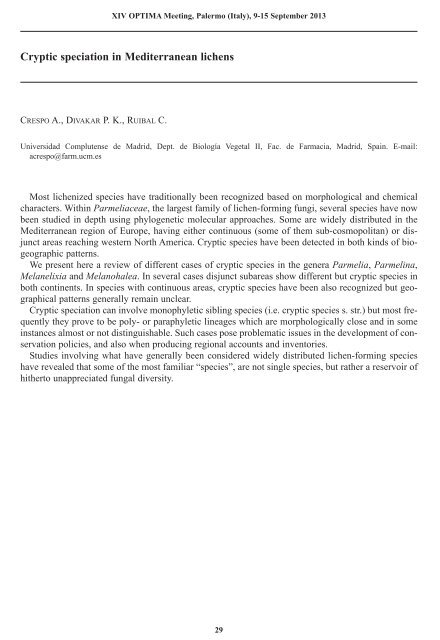Abstracts, XIV OPTIMA Meeting, Palermo (Italy) , 9-15
Abstracts, XIV OPTIMA Meeting, Palermo (Italy) , 9-15
Abstracts, XIV OPTIMA Meeting, Palermo (Italy) , 9-15
Create successful ePaper yourself
Turn your PDF publications into a flip-book with our unique Google optimized e-Paper software.
<strong>XIV</strong> <strong>OPTIMA</strong> <strong>Meeting</strong>, <strong>Palermo</strong> (<strong>Italy</strong>), 9-<strong>15</strong> September 2013<br />
Cryptic speciation in Mediterranean lichens<br />
CRESPO A., DIVAKAR P. K., RUIBAL C.<br />
Universidad Complutense de Madrid, Dept. de Biología Vegetal II, Fac. de Farmacia, Madrid, Spain. E-mail:<br />
acrespo@farm.ucm.es<br />
Most lichenized species have traditionally been recognized based on morphological and chemical<br />
characters. Within Parmeliaceae, the largest family of lichen-forming fungi, several species have now<br />
been studied in depth using phylogenetic molecular approaches. Some are widely distributed in the<br />
Mediterranean region of Europe, having either continuous (some of them sub-cosmopolitan) or disjunct<br />
areas reaching western North America. Cryptic species have been detected in both kinds of biogeographic<br />
patterns.<br />
We present here a review of different cases of cryptic species in the genera Parmelia, Parmelina,<br />
Melanelixia and Melanohalea. In several cases disjunct subareas show different but cryptic species in<br />
both continents. In species with continuous areas, cryptic species have been also recognized but geographical<br />
patterns generally remain unclear.<br />
Cryptic speciation can involve monophyletic sibling species (i.e. cryptic species s. str.) but most frequently<br />
they prove to be poly- or paraphyletic lineages which are morphologically close and in some<br />
instances almost or not distinguishable. Such cases pose problematic issues in the development of conservation<br />
policies, and also when producing regional accounts and inventories.<br />
Studies involving what have generally been considered widely distributed lichen-forming species<br />
have revealed that some of the most familiar “species”, are not single species, but rather a reservoir of<br />
hitherto unappreciated fungal diversity.<br />
29






